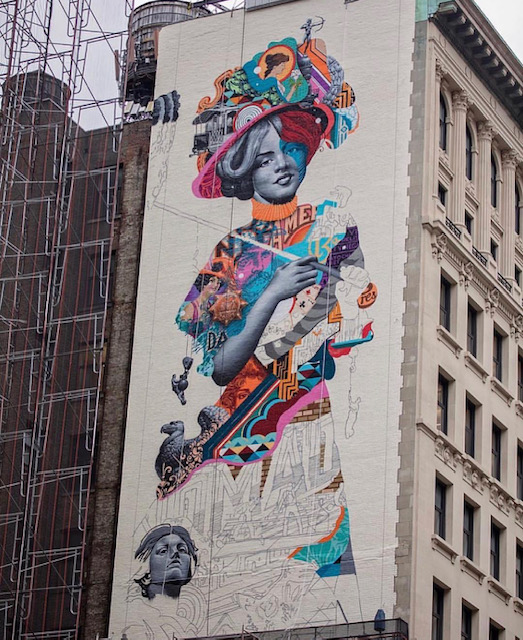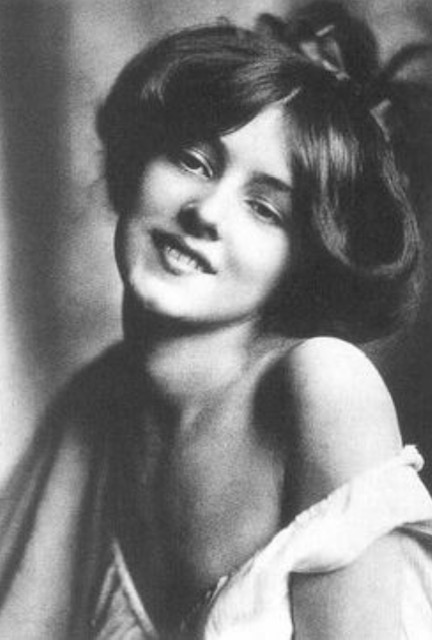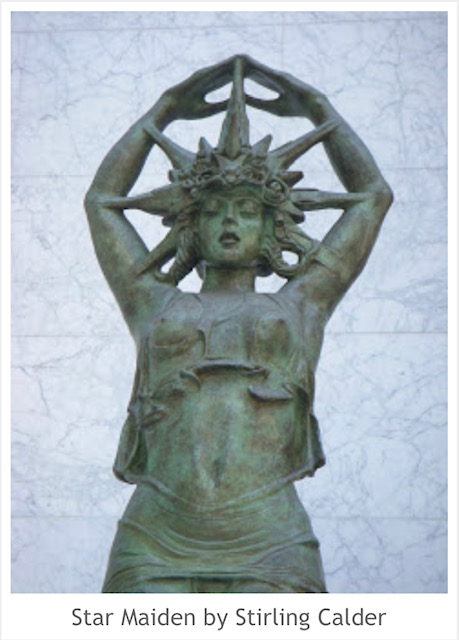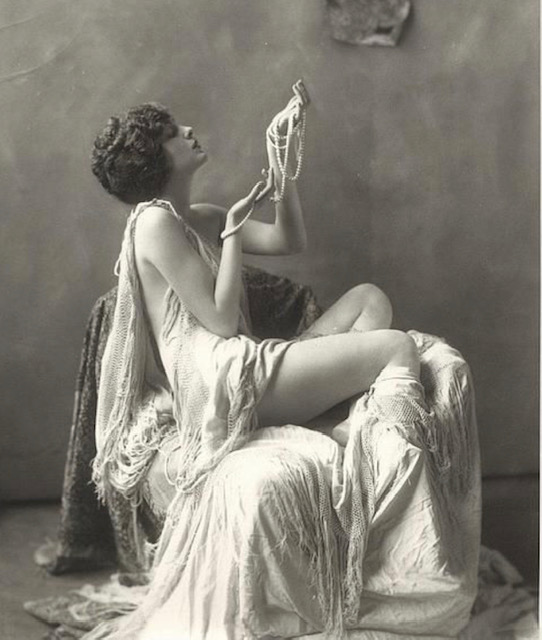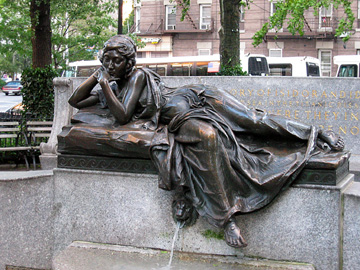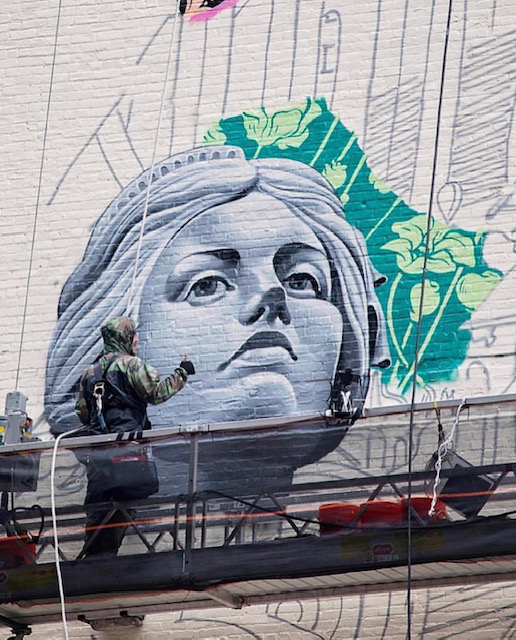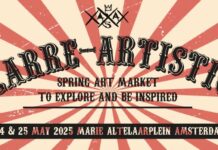The Gilded Lady
After scrolling through my Instagram account, searching for the most-liked picture, I arrived at a picture I took in 2017 in New York. It is the Audrey Hepburn by Tristan Eaton in Little Italy. Audrey’s cute face is depicted in Eaton’s colorful cartoonish style – a style that has something distinctly all-American about it. What is it, I wondered, that makes his style so recognizable? The collage-like structure of the image, the illusion of different textures, the super-tight, almost plastic-like 3D illusion that in a strange way also looks very flat? This is an artist with multiple qualities. As if artistic versatility and aesthetics alone aren’t reason enough to find out more about his new work, his latest NoMAD mural is also worth deciphering for its cultural subtext.
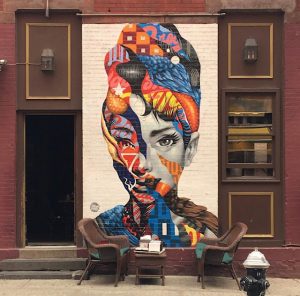
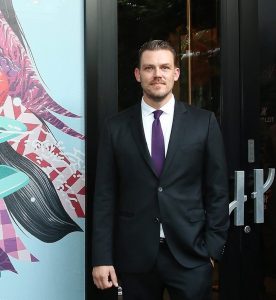
North of Madison Square park
Last week the first contours of the new Tristan Eaton Mural appeared on the façade of a building in the NoMAD area of New York. It looks like a representation of a woman from the nineteenth century. Dying to know more, I found out that the NoMAD district became the center of New York’s social and cultural life in The Gilded Age (1890s to about 1920). It was the hub of theatre, entertainment, shopping and nightlife, and it was a favorite spot for the likes of Oscar Wilde, Mark Twain, Charles Dickens, Thomas Edison and Teddy Roosevelt. In addition, the neighborhood, with its many hotels, bars, dancehalls and casinos attracted a considerably less elite public of prostitutes and hustlers. The mix of people from very diverse walks of life formed the essence of the neighborhood.

Evelyn Nesbit and Audrey Munson
Eaton’s mural portrays many public places and things from The Gilded Age, as well as two remarkable woman; the models and socialites Evelyn Nesbit and Audrey Munson. Nesbit gained worldwide notoriety when her husband, the mentally unstable multimillionaire Harry Kendall Thaw, shot and killed the prominent architect and New York socialite Stanford White in the fully packed rooftop theatre of Madison Square Garden on the evening of June 25, 1906. The resulting trial was dubbed “The Trial of the Century” by the press. Over its course, Nesbit testified that five years earlier, performing on stage at the age of 15 or 16, she had attracted the attention of White, who first gained her and her mother’s trust, then sexually assaulted her while she was unconscious, and subsequently had a romantic and sexual relationship with her.
Audrey Munson, today considered to have been America’s first supermodel, was also variously known as “Miss Manhattan”, the “Panama–Pacific Girl”, the “Exposition Girl” and “American Venus”. She was the model and inspiration for more than twelve statues in New York, and many more beyond it.
Another crime passionnel…
In 1919 Audrey Munson was living with her mother in a boarding house at 164 West 65th Street, Manhattan, owned by Dr. Walter Wilkins. Wilkins fell in love with Munson, and on February 27 murdered his wife, Julia, so he could be available for marriage. Munson and her mother left New York, while sought for questioning by the police. They were found after a nationwide hunt. Refusing to return to New York, they were questioned by agents from the Burns Detective Agency in Toronto, Ontario, Canada. The contents of the affidavits they supplied have never been revealed, but Audrey Munson strongly denied she had any romantic relationship with Dr. Wilkins. Wilkins was tried, found guilty, and sentenced to the electric chair. He hung himself in his prison cell before the sentence could be carried out. The Wilkins killing marked the end of Munson’s ten-year modeling career. After a few desperate attempts to reboot her career, Munson disappeared completely from the spotlight. On May 27, 1922, Munson attempted suicide by swallowing a solution of bichloride of mercury. On June 8, 1931, her mother petitioned a judge to commit her to a ‘lunatic asylum’. The Oswego County judge did in fact order Munson be admitted into a psychiatric facility for treatment. She remained in the St Lawrence State Hospital for the insane in Ogdensburg, where she was treated for depression and schizophrenia for the duration of 65 years, until her death at the age of 104 (!)
Me-too
Is it a coincidence that Eaton portrays these sexually victimized women on a wall in what was once the center of the entertainment industry? Could it be a reference to the #MeToo-movement, which sprang to life in 2017 in reaction to sexual violence and intimidation by Harvey Weinstein, Bill Cosby (who, coincidentally, shared Mr. White’s modus operandi), and so many other men in power.
The following quote from Audrey Munson speaks for itself:
“What becomes of the artists’ models? I am wondering if many of my readers have not stood before a masterpiece of lovely sculpture or a remarkable painting of a young girl, her very abandonment of draperies accentuating rather than diminishing her modesty and purity, and asked themselves the question, “Where is she now, this model who was so beautiful?”
Munson felt herself made into an object, praised for her beauty and body, not seen for who she was: a girl and a human being.
***
About Tristan Eaton
Eaton, born in Hollywood in 1978, began pursuing Street Art as a teenager in London in the late ’80s and early ’90s. His talent soon found expression beyond graffiti, as he expanded into wall art, graphic design, logo and packaging design, sculpture and toy design. At the age of 18 he created his first toy for Fisher Price and has since become a driving force in the world of ‘Designer Toys’. Shortly after studying at the School of Visual Arts in New York City, he founded de Tristan Thunderdog Studios, of which he has been the President and Creative Director for the past 10 years. Eaton’s design work for Kidrobot, including the infamous Dunny and Munny toys, garnered international fame and an ever growing fan base.

